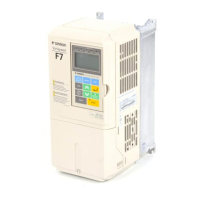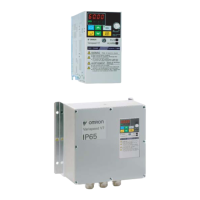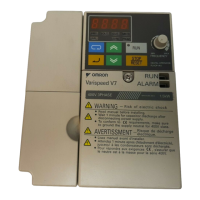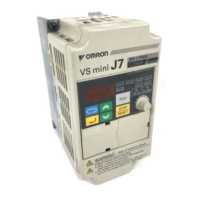7-4
Motor Overheat
Detected when the level at A2,
programmed for motor tempera-
ture (thermistor input, H3-09=E),
exceeds 1.17 V for the time L1-
05 and L1-03 = 0 to 2.
Overheating of the motor has
been measured by the motor ther-
mistor.
• Check the cycle time and
the size of the load.
• Check the accel/decel times
(C1-).
• Check the V/f pattern
(E1-)
OH3
Motor Overheat 1
Motor Overheat
Detected when the level at A2,
programmed for motor tempera-
ture (thermistor input, H3-09=e),
exceeds 2.34 V for the time L1-
05.
Overheating of the motor has
been measured by the motor ther-
mistor.
• Check the cycle time and
the size of the load.
• Check the accel/decel times
(C1-).
• Check the V/f pattern
(E1-)
OH4
Motor Overheat 4
Motor Overload
Detected when L1-01 = 1 to 3 and
the Inverter’s output current
exceeded the motor overload
curve.
Refer to
page 6-33 for parameter
settings.
• The load is too large. The
acceleration time, deceleration
time and cycle time are too
short.
• The voltage settings of the V/f
pattern is incorrect for the
application
• The setting of the Motor Rated
Current (E2-01) is incorrect.
• Check the cycle time, the
size of the load and the
accel/decel time settings
(C1-).
• Check the setting of the V/f
pattern (E1-).
• Check the setting of Motor
Rated Current (E2-01)
OL1
Motor Overload
Inverter Overload
The internally calculated I²t value
(based on the Inverter rated cur-
rent) has exceeded its detection
level.
• The load is too large. The
acceleration time, deceleration
time and cycle time are too
short.
• The voltage settings of the V/f
pattern is incorrect for the
application
• The capacity of the Inverter is
too small
• Check the cycle time, the
size of the load and the
accel/decel time settings
(C1-).
• Check the setting of the V/f
pattern (E1-).
• Check the setting of Motor
Rated Current (E2-01)
• Check if the Inverter rated
current matches the motor
rated current.
OL2
Inv Overload
Overload Detection
Inverter’s output current
exceeded L6-02 for longer then
the time set in L6-03 and L6-
01=3 or 4.
Motor was overloaded
• Ensure the values in L6-02
and L6-03 are appropriate
• Check the application/
machine status to eliminate
fault.
OL3
Overtorque Det 1
High Slip Braking OL
The output frequency stayed con-
stant for longer than the time set
in n3-04 during High Slip Brak-
ing.
The inertia of the load is too
large.
• Make sure the load is an
inertial load.
• If possible, reduce the load
inertia
OL7
HSB OL
Loss of Load Detection
Inverter’s output current was
below L6-02 for longer then the
time set in L6-03 and
L6-01= 7 or 8.
Motor lost its load
• Make sure that the settings
in L6-02 and L6-03 are
appropriate.
• Check the mechanical sys-
tem (mechanical connection
of the load, e.g. belt).
LL3
Loss of Load Det
PI Feedback Lost
This fault occurs when PI feed-
back loss detection is pro-
grammed to fault (b5-12 = 2) and
the PI feedback fell below the PI
Feedback Loss Detection Level
(b5-13) for the PI Feedback Loss
Detection Time (b5-14)
PI feedback source (e.g. trans-
ducer, sensor, building automa-
tion signal) is not installed
correctly or is not working
• Check the PI feedback sig-
nal source for correct opera-
tion.
• Check the wiring of the PI
feedback signal.
FBL
Feedback Loss
Table 7.1 Fault Detection
Display Meaning Probable Causes Corrective Actions
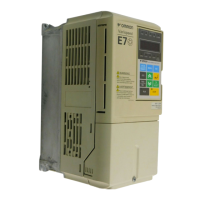
